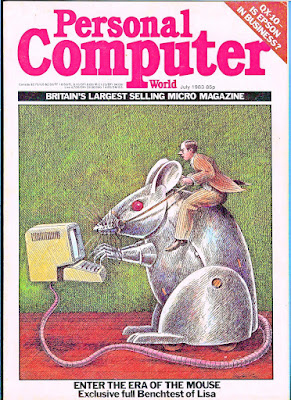Launched January 1983
In 1983 the Apple Computer Company was just seven years old, but had grown very rapidly on the back of strong sales of the Apple II. By the early 1980s though, the Apple II was looking increasingly out-of-date. In 1980 the Apple III was launched, designed to fix many of the shortcomings of its predecessor, but it was a deeply unreliable and poorly-built product and was a sales disaster.
The launch of the IBM PC in 1981 saw Apple struggling in the business market, so it was very important that whatever they came up with next would be a success. Sadly for Apple, their next product – the Apple Lisa – ended up as another disaster, even if it did seem to hold great promise.
 |
| Apple Lisa 1 |
The key feature of the Lisa was the mouse-drive graphical interface, the computer unit itself was an elegant single-box design with an integrated 12 inch monitor. It looked very different in both hardware and software terms from the competition, and both the mainstream media and specialist press were very excited.
Development of the Lisa had started years earlier, at first with modest aims but quickly becoming influenced by the work that fellow Silicon Valley engineers at Xerox were doing with their Alto platform which was being developed into the Xerox Star. When Steve Jobs saw the Alto’s graphical interface he was highly impressed, and the Apple team sought to emulate and improve on it. The concepts of the mouse-driven user environment were not new - Doug Engelbart had demonstrated the concepts as far back as 1968 – but it was only really in the 1980s that computer hardware started to become affordable enough to make it a reality.
 |
| The mouse was still a novelty when the Apple Lisa was launched, as this cover from Personal Computer World shows |
Unlike previous Apple models which were based on the 6502, the Lisa was built around a Motorola 68000, clocked at 5MHz along with one megabyte of RAM. Neither the CPU nor RAM were very fast, even by 1983 standards. The display was a 720 x 364 pixel black-and-white unit with no greyscale capabilities. Twin 5.25-inch variable speed floppy drives (known by the name “Twiggy”) offered a lot of storage, but were very unreliable. The Lisa was also designed to be used with a 5MB external hard drive, and a variety of printers were available.
The look and feel of the operating system was far in advance of everything outside of Xerox’s labs. Based largely around the file manager, it became the template for the OS used on the later Macintosh. A crude form of protected memory was available, but overall the operating system ran sluggishly on the hardware. The Lisa had a variety of office applications available, including a word processor, spreadsheet, graphical applications and utilities.
This may all sound very familiar because the Macintosh, launched a year later, also did many of the things that the Lisa did. But the Lisa is not the Mac’s predecessor, instead this ended up as a dead end which cost Apple a lot of money. Not only was the hardware and software unstable, but the price of the Lisa started at an eye-watering $9,995 in 1983 money (around $30,000 today). Any appeal that the Lisa may have had was undermined by the launch of the Apple Macintosh in 1984, which did most of the things the Lisa could do, but more reliably and at a quarter of the price.
The Lisa flopped, selling only about 10,000 units. A redesigned Lisa 2 in 1984 was cheaper, more reliable but more underpowered than the original. There was some interest from customers who wanted a device with a bigger display than the standard Mac, but the Lisa needed an emulator to run Mac software. In 1985 the final iteration of the Lisa was launched, as the Macintosh XL which proved to be at least of interest to consumers, but Apple ended up selling it at a loss.
Killed off by its own internal competition, a combination of cheap or untested components and an enormous price tag, the Lisa is one of the biggest failures in the history of Apple. Conversely the cut-down and more focussed version, the Macintosh, was one of the biggest successes. Today, a working Lisa system is very collectible and commands prices of thousands of dollars, although you are more likely to find the later Lisa 2 than the original.
Image credits:
Timothy Colegrove via Wikimedia Commons - CC BY-SA 4.0
Paul Downey via Flickr – CC BY 2.0

No comments:
Post a Comment